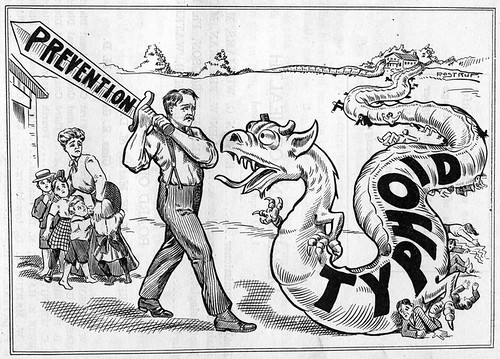Typhoid Fever
By Barbara Schock
As each summer ended in
the 19th century, many communities like Galesburg
endured an outbreak of typhoid fever. City
officials warned citizens to boil all water used
for drinking and cooking. Householders were urged
to protect food from flies and put screens on open
windows. Doctors were required to report all cases
of typhoid fever to city officials. It was
important to know if an epidemic was developing.
Typhoid is a common
bacterial disease transmitted by eating or
drinking food or water contaminated by the feces
of an infected person. There are four stages of
the disease, each of about one week’s duration.
During the first week, the temperature of the
patient rises gradually and is accompanied by
headache, cough and abdominal pain. The second
week, a high temperature develops and plateaus at
about 104 degrees. The patient may be delirious
and develops diarrhea as well as rose spots on the
abdomen. By the third week, complications may
develop with intestinal hemorrhaging or
perforations. The fever is still high and the
patient may become dehydrated. The fever begins to
subside by the fourth week.
Untreated cases may result
in 10 to 30 percent fatalities. The disease is
still endemic in parts of South America, Africa,
India and the Far East, with an estimated 16 to 30
million cases annually. It most often strikes
children and young adults.
The site selected by the
Reverend George Washington Gale and his companions
for the establishment of Galesburg included a
creek and several springs. The pioneers were well
aware a source of water was necessary. As the
community grew, many residents dug their own wells
near their houses. Outdoor privies were placed at
the rear of the long residential lots. On occasion
there could be migration of liquid through the
ground or a person who carried the typhoid
bacteria might have contaminated the water supply.
There is no evidence any
members of Carl Sandburg’s family contracted
typhoid. The cleanliness of the city’s Swedes made
it likely they would be careful to protect their
well, cover food to keep it from flies and would
wash their hands as often as practicable.
Galesburg struggled with
drinking water supply and waste water treatment
issues for decades. Artesian wells were created to
provide water for the community, but were not
sufficient for emergency needs. Building a
distribution system for tap water as well as
treatment for waste water were monumental
projects. Today, the city has efficient systems in
place which serve the residents.
The chlorination of public
water systems began in 1908 and spread across the
country. The incidence of typhoid and similar
diseases began to decline. For example, in 1891
the rate of infection was 174 per 100,000 people.
Today, it is five infections per million people.
By 1914, the U.S. Public
Health Service had set standards for the
bacteriological quality of drinking water. In
1962, 28 difference substances in water were
regulated by the federal government. The Safe
Drinking Water Act was approved by Congress in
1984 and has been updated several times.
In recent years, more than
fifty active pharmaceutical ingredients have been
found in treated drinking water. There is also
ongoing research into organisms which may live
within the water distribution systems. The 53,000
water treatment facilities within the United
States still have a great deal of work to do in
providing safe drinking water to their
constituents. However, typhoid is no longer the
threat it once was.
